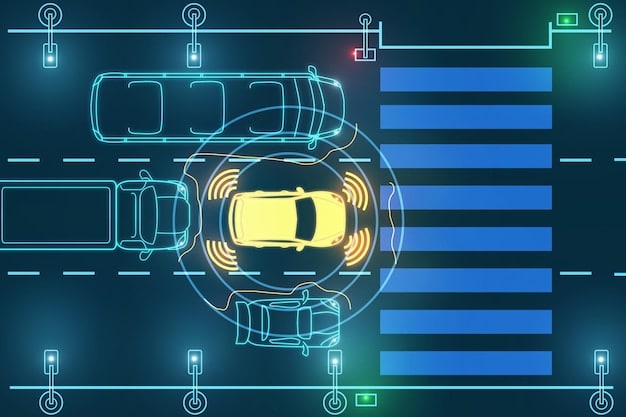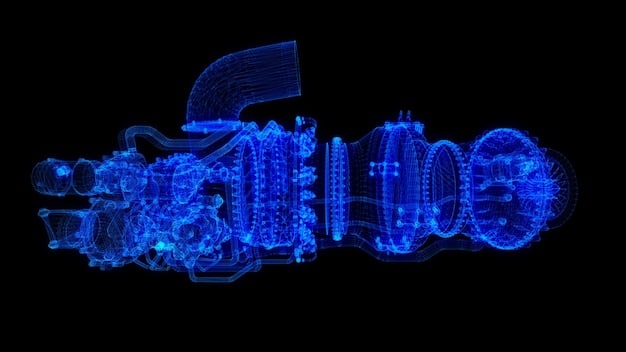How AI is Revolutionizing Vehicle Safety and Performance in the Auto Industry

Automakers are increasingly leveraging artificial intelligence (AI) to enhance vehicle safety by implementing advanced driver-assistance systems (ADAS) and predictive maintenance, and to improve vehicle performance through optimized engine control and personalized driving experiences.
The automotive industry is undergoing a significant transformation, driven by the integration of artificial intelligence (AI). Automakers are harnessing the power of AI to not only make vehicles safer but also to enhance their overall performance. From advanced driver-assistance systems to predictive maintenance, how are automakers using artificial intelligence to improve vehicle safety and performance is revolutionizing the driving experience.
AI-Powered Advanced Driver-Assistance Systems (ADAS)
Advanced Driver-Assistance Systems (ADAS) are at the forefront of AI applications in automotive safety. These systems use a combination of sensors, cameras, and radar to provide drivers with real-time information and assistance, helping to prevent accidents and improve overall driving safety.
ADAS technologies are designed to mitigate human error, which is a leading cause of traffic accidents. By providing timely alerts and interventions, these systems can significantly reduce the risk of collisions and enhance the safety of drivers and passengers.
Key Features of AI-Enabled ADAS
AI enhances ADAS functionalities, making them more responsive and accurate. Here are some key features:
- Adaptive Cruise Control (ACC): Maintains a safe distance from the vehicle ahead, automatically adjusting speed as needed.
- Lane Departure Warning (LDW): Alerts the driver if the vehicle begins to drift out of its lane.
- Automatic Emergency Braking (AEB): Detects potential collisions and automatically applies the brakes to avoid or mitigate the impact.
- Blind Spot Monitoring (BSM): Monitors the vehicle’s blind spots and alerts the driver to the presence of other vehicles.
These ADAS features continuously learn and adapt, improving their performance over time through machine learning algorithms. This constant refinement ensures that the systems remain effective in various driving conditions.

In conclusion, AI-powered ADAS represents a significant leap forward in automotive safety. By providing drivers with advanced assistance and intervention capabilities, these systems are helping to reduce accidents and make roads safer for everyone.
Predictive Maintenance and Vehicle Health Monitoring
AI is also playing a crucial role in predictive maintenance, enabling automakers to monitor vehicle health in real-time and anticipate potential issues before they lead to breakdowns. This proactive approach helps to reduce downtime, lower maintenance costs, and improve overall vehicle reliability.
By analyzing data from various sensors throughout the vehicle, AI algorithms can identify patterns and anomalies that may indicate impending failures. This allows for timely maintenance interventions, preventing costly repairs and ensuring vehicle safety.
Benefits of AI-Driven Predictive Maintenance
Predictive maintenance offers several key benefits to both vehicle owners and automakers:
- Reduced Downtime: Identifying and addressing potential issues before they lead to breakdowns minimizes vehicle downtime.
- Lower Maintenance Costs: Preventative maintenance is generally less expensive than reactive repairs.
- Improved Vehicle Reliability: Regular monitoring and timely interventions ensure that the vehicle operates at peak performance.
- Enhanced Safety: Addressing potential safety-related issues before they become critical helps to prevent accidents.
AI-driven predictive maintenance is transforming the way vehicles are maintained, shifting from a reactive approach to a proactive one. This results in safer, more reliable, and more cost-effective vehicle operation.
Optimizing Engine Control and Performance with AI
AI is being used to optimize engine control systems, improving fuel efficiency, reducing emissions, and enhancing overall vehicle performance. These systems use machine learning algorithms to adapt to various driving conditions, providing optimal engine performance at all times.
By continuously monitoring and adjusting engine parameters, AI can fine-tune the combustion process, maximizing power output while minimizing fuel consumption. This leads to a more efficient and environmentally friendly vehicle.

How AI Optimizes Engine Performance
AI-powered engine control systems employ various techniques to optimize performance:
- Real-Time Adjustments: AI algorithms continuously monitor and adjust engine parameters such as fuel injection, ignition timing, and air intake.
- Adaptive Learning: The system learns from past driving experiences, adapting its performance to suit individual driving styles and conditions.
- Emission Reduction: AI optimizes the combustion process to minimize harmful emissions, helping to meet stringent environmental regulations.
- Fuel Efficiency: By fine-tuning engine parameters, AI maximizes fuel efficiency, reducing fuel consumption and saving drivers money.
The application of AI in engine control systems represents a significant advancement in automotive technology. By optimizing engine performance in real-time, these systems are making vehicles more efficient, environmentally friendly, and enjoyable to drive.
Personalized Driving Experiences Through AI
AI is enabling automakers to create personalized driving experiences tailored to individual preferences and habits. These systems use machine learning to understand driver behavior and adjust vehicle settings accordingly, providing a more comfortable and enjoyable ride.
From automatically adjusting seat positions and climate control settings to recommending optimal routes and music playlists, AI can customize virtually every aspect of the driving experience. This level of personalization enhances driver satisfaction and makes each journey more pleasant.
AI in Autonomous Driving Systems
Autonomous driving is perhaps the most ambitious application of AI in the automotive industry. Self-driving cars rely heavily on AI algorithms to perceive their surroundings, make decisions, and navigate roads safely. These systems use a combination of sensors, cameras, and radar to create a comprehensive understanding of the vehicle’s environment.
AI algorithms process this data in real-time, identifying objects, predicting their movements, and planning safe and efficient routes. As autonomous driving technology continues to evolve, AI will play an increasingly important role in shaping the future of transportation.
Challenges and Future Directions
While AI has made significant strides in autonomous driving, several challenges remain:
- Safety and Reliability: Ensuring the safety and reliability of autonomous systems in all driving conditions.
- Ethical Considerations: Addressing ethical dilemmas that may arise in autonomous driving scenarios.
- Regulatory Frameworks: Developing clear and consistent regulatory frameworks for autonomous vehicles.
Despite these challenges, the future of autonomous driving is bright, with AI at the forefront of innovation. As technology continues to advance, self-driving cars are poised to revolutionize the way we travel.
The Future of AI in Automotive: Trends and Predictions
The integration of AI into the automotive industry is set to accelerate in the coming years, with several key trends and predictions shaping the future:
- Enhanced Safety Features: AI will continue to improve ADAS and predictive maintenance systems, leading to safer vehicles and fewer accidents.
- Greater Personalization: AI will enable even more personalized driving experiences, tailored to individual preferences and habits.
- Advancements in Autonomous Driving: AI will drive the development of fully autonomous vehicles, transforming the way we travel.
As AI technology continues to evolve, it will play an increasingly important role in shaping the future of the automotive industry. From enhancing safety and performance to enabling new levels of personalization and autonomy, AI is revolutionizing the driving experience.
| Key Point | Brief Description |
|---|---|
| 🛡️ ADAS with AI | Enhances safety via adaptive cruise control and emergency braking. |
| 📊 Predictive Maintenance | Uses AI to monitor vehicle health and prevent breakdowns. |
| 🚗 Optimized Engine Control | AI optimizes fuel consumption, emissions, and performance. |
| 🧑💼 Personalized Driving | AI adapts vehicle settings to driver preferences for comfort. |
Frequently Asked Questions
▼
AI primarily enhances vehicle safety by improving ADAS, enabling features like automatic emergency braking, lane keep assist, and adaptive cruise control. These systems react faster and more accurately than humans, reducing accident risks.
▼
AI enhances vehicle performance by optimizing engine control systems for better fuel efficiency and lower emissions. AI algorithms continuously adjust parameters like fuel injection and ignition timing, adapting to different driving conditions.
▼
Predictive maintenance uses AI to analyze vehicle data and predict when maintenance is needed. By monitoring sensor data, AI can identify patterns indicative of potential failures, allowing for timely repairs and preventing breakdowns.
▼
AI personalizes the driving experience by adjusting vehicle settings to match individual driver preferences. AI learns driver habits and automatically adjusts things like seat position, climate control, and entertainment options for a more comfortable ride.
▼
Challenges in AI for autonomous driving include ensuring safety and reliability in all conditions, addressing ethical dilemmas, and establishing clear regulatory frameworks. These challenges require ongoing research and development to overcome.
Conclusion
In conclusion, AI is transforming the automotive industry by improving vehicle safety, enhancing performance, enabling predictive maintenance, personalizing the driving experience, and paving the way for autonomous driving. As AI technology continues to advance, it will play an increasingly important role in shaping the future of transportation.





